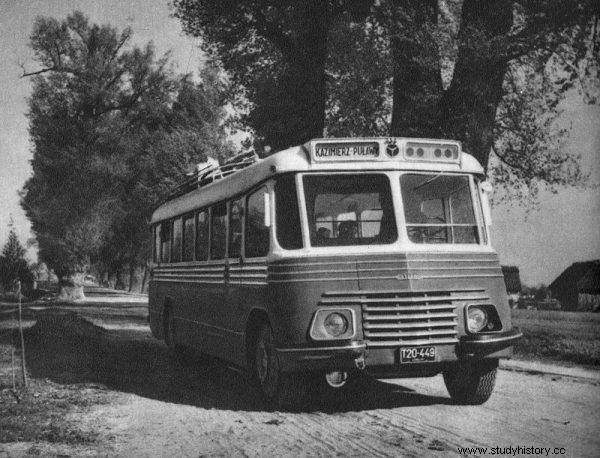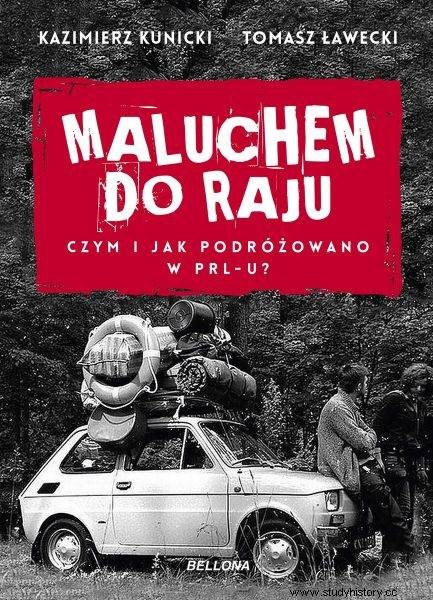Destroyed roads, no cars - this was the shortest assessment of the post-war situation. And how to live without car transport, especially when the railway network is only painstakingly rebuilding? It's not possible! Fortunately for Poles, a relief has come in the form of ... used cars from the West (and not only). Sounds familiar?
At first, even the government had nothing to drive, so the Ministry of National Defense donated a pool of military vehicles to state officials. However, it had to be adjusted to European standards. In accordance with the well-known sentence of Jerzy Urban that "the government will feed itself", soon a government car fleet was created from imported American Chevrolets, Buicks and Cadillacs. On the other hand, the burning automotive problem remained in the entire economic and social life. From up to down. From big to small.
PKS from Canada
At the end of October 1945, offices registered 10,992 trucks, 46 buses and 6,422 passenger cars - all over Poland! Mostly American production, military trucks with a carrying capacity of 1.5 and 3 tons.
First, eight hundred cars were handed over to us by the commands of the American and Canadian armies, then "Aunt UNRRA" started with her deliveries. By the end of 1946, it had delivered over 25,000 sq m to Poland. trucks, mainly from surplus, but also 3,000 new Chevrolets, which we called Canada.
This was due to the fact that the production of these cars began before the Japanese air attack on Pearl Harbor, when the United States was neutral, and therefore under international law could not produce equipment for the warring parties . Canada is different. From there, they were transferred to the Canadian and British, Australian and New Zealand armies, as well as the Soviet armies, and through it to the Polish People's Army.

PKS bus on the route Kazimierz Dolny - Puławy, early years. 50.
The strong and maneuverable Canada had a cabin located above the engine and a distinctive windshield mounted at a negative angle. The drivers assessed them very well. They ran on Polish roads until the end of the 1950s, then replaced by domestic-made cars.
They did well in the reconstruction of Poland and initially were also the basic fleet of the State Automobile Communication. They were adapted in various ways, for example on the Kraków-Zakopane line there were Canadians with white bodies decorated with a blue belt. PKS field structures were created from July 1945 based on the demobilized car units of the Polish Army. Until the 1980s, PKS served almost all long-distance and suburban bus transports, as well as transport of goods.
Peaceful village, cheerful village
I remember that at the end of the 1940s, together with my sister, under my mother's care, we went from Warsaw for Easter to uncle Jan Kołodziejski, who was an agronomist from pre-war education, who became the manager of the organized state farm in Czartajewo in Podlasie.
There was already a railroad to Siemiatycze, but no further. We got to Czartayev on such a canada, full of happiness, otherwise it would not have been possible. I mention it because this Czartayev was like a showcase of the Bug River village of the early Polish People's Republic and generally of the regions we now call the "eastern wall". There was no electricity, enough to recall that even twenty years later, over 700,000 farms, mainly in central and south-eastern voivodships, did not have energy supplied yet.
Thus, in his uncle's apartment, the object of his special care was a crystal radio, powered by a car battery. Dinners and the whole evening life took place in a romantic atmosphere, with kerosene lamps. The water supply consisted of wells with a bucket on a chain pulled out from a wooden cylinder with a crank. Sometimes there were also so-called cranes, the wooden supports of which reached 10 meters in deep wells.
The bathroom was equipped with a basin, a jug with clean water and a bucket. No one dreamed of plumbing, the outhouse was a wooden booth with a heart cut into the door as an inspection window, set over a deep dug hole.

The text is an excerpt from the book "Maluszek do raju. What and how did people travel in the People's Republic of Poland? " , by Kazimierz Kunicki and Tomasz Ławecki. It was published by the Bellona publishing house.
By the way, this standard became popular in the Polish countryside only in the interwar period, when the Sanacja Prime Minister General Felicjan Sławoj Składkowski carried out a hygienic modernization action; his successful efforts were honored by the society with the commonly used name of these secluded booths - "outhouses".
Easter in Czartajewo happened to me only once, because some kind anonymous - such were the times - accused my uncle of economic sabotage. His uncle ended up in the detention center of the Bialystok security services, full of experts in interrogation, not in agriculture, and because his class origin was still not well perceived at the time, he had to convince them for a long time that plowing up a good lupine as an aftercrop, which he ordered, was not a harm, but on the contrary makes the field fertile for the future cultivation.
He left the security service prison wasted, in Czartajewo he ended his term of office and went to the capital, to one of the ministries as the manager of departmental auxiliary farms. I mention them because they were a special creation of real socialism, separated enclaves in the planned economy, and their agricultural production, and especially breeding, served only the state owner and the institutions indicated by him as - very highly valued - supplementing the lean market supplies.
The revival of the dead
Coming back to the US car shipment, the problem was that the overwhelming majority was used, and a lot of it. For example, one of the October 1945 Ford and Chevrolet deliveries was estimated at only 20% of the vehicles running.
Broken windows, broken bumpers, bent car bodies, damaged equipment, broken starters, generators, gasoline pumps, leaky radiators, damaged electrical installations, completely discharged batteries, rolled and moldy tarpaulins, scuffed protectors in tires, no spare wheels, here is a shortened list of deadly sins. As noted in the minutes of the official supervising the receipt of the entire delivery, these were cars that went through the African campaign from El-Alameyn to Tunis, and then the Italian campaign, and their mileage reached 35 thousand. miles!
The recipients initially paid the amount fixed for a given brand and model, without taking into account the actual condition, which caused understandable quarrels and protests that reached Prime Minister Osóbka-Morawski, after which the price list was differentiated.
The second big problem was, as it was described, the "terrifying variety" of 22 brands and the lack of spare parts. Yes, from time to time there were crates filled with them like peas and cabbage and without documentation, without any description. So it is easy to imagine how difficult it was to revive such dead bodies.
See also:People were starving, and they stole by power. How did the employees of the communist Ministry of the Interior try to get rich with gold from the "rotten West"?
Second hand cars
Regardless of the UNRRA deliveries, two car purchases were launched under loan agreements, codenamed "A-50" - American surplus, and "B-6" - British; The mission "A-50" located in Paris was led by Zygmunt Modzelewski, soon appointed head of the Ministry of Foreign Affairs. The French and Italians also sold us cars for deliveries of coal.
Another source was purchases from the Soviet Army of very different brands and models, ranging from the local ZIS-5 trucks, which did well during World War II, and ending with American-made vehicles, which the Soviet Union received 427 thousand under the so-called lend-lease. .! Let's add some post-German cars to that.
As a result of all these activities in the first half of 1948 on Polish roads - according to the data of the Ministry of Communications - already over 93,000 people were driving. motor vehicles, including less than 30 thousand. trucks and just over 26 thousand. personal. Aleksander Rostocki, an expert on the subject, estimated the number of brands, types and models in Życie Gospodarczego ... several hundred! The new ones competed with the oldtimers, it all appeared together as a living motoring museum.

Chausson bus on a Warsaw street, next to it a truck carrying passengers
In addition, with the intensifying "cold war" still sharply dividing Europe with the "iron curtain", importing spare parts for Western cars turned out to be more and more difficult, even when hard currency was scrapped for it.
In order to somehow manage this, the Economic Committee of the Council of Ministers (KERM) in February 1949 adopted a somewhat bizarre resolution defining which brands were typical vehicles - worth major repairs, and which ones were unusual - not suitable for such reanimation. It was supported by the order that state offices to dispose of unnecessary and overtime cars, as well as difficult to implement restrictions on the range of permitted business trips. Half of the rolling stock was planned for deletion in the same year 1949.
The situation was becoming dramatic, some improvement was to be brought by imports from Czechoslovakia. It was not appropriate to transport the inhabitants of the capital coming back to life with military trucks for too long. Eight buses were recovered and renovated from the ruins, and UNRRA provided Warsaw with ten double-decker leylands that ran around London; a ride on the upper floor, necessarily by the window, was a real attraction for the kids.
On the eve of the Renaissance on July 22, 1947, the first eight AH48 chaussons imported from France entered the streets. Due to the extended engine hood, they were called nez de cochon in their homeland. , that is pig snouts. Modern and durable, they could accommodate up to eighty passengers, including thirty seated. Their premiere was a real celebration, and among the first selected passengers were Władysław Gomułka, the first secretary of the ruling Polish Workers' Party, and Prime Minister Józef Cyrankiewicz.
In total, almost eight hundred chaussons reached Poland, and they served in public transport until the end of the 1960s. From 1951, Hungarian Ikarus boats serving many large cities were also imported.
Source:
The text is an excerpt from the book "Maluszek do raju. What and how did people travel in the People's Republic of Poland? " , by Kazimierz Kunicki and Tomasz Ławecki. It was published by the Bellona publishing house.
